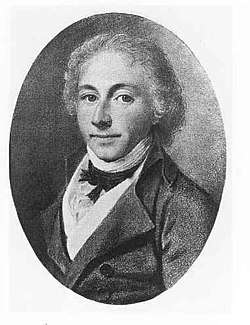Frantz Hohlenberg
Frantz Christopher Henrik Hohlenberg[1][2] was a Danish naval officer who specialised in ship design and had little seagoing experience.

Career
Born 18 February 1764, he became a junior lieutenant in the Danish Navy at the age of 18 and began an apprenticeship with the Danish Construction Commission. Soon after his appointment, he made a study tour of naval establishments of southern Europe, and later of Sweden and Russia. He was considered the most gifted of Henrik Gerner's pupils when Gerner was fabrikmester at Copenhagen and inherited all of Gerner's papers on the latter's death.[2] In 1795 he became a lecturer in shipbuilding at the Naval Cadet Academy and at the same time a fully fledged member of the Construction Commission. Promoted to the most senior lieutenant's rank[Note 1] in 1796, he became interim fabrikmester (master shipbuilder to the Royal Danish-Norwegian Navy) as his predecessor E W Stibolt retired on health grounds,[2][Note 2][1] a position confirmed in 1797.
In 1801 he was appointed to the Defence Commission.[2]
A report which disapproved of his handling of the building of the frigate Rota upset him greatly[2] and at the age of 38, in 1803, Hohlenberg resigned his post and travelled to the Danish West Indies to become harbourmaster and chief pilot at Christiansted on St Croix. He died shortly after arrival on 9 January 1804. He was buried on the island, but the position of his grave was not recorded.[1]
The position of fabrikmester at the Danish Naval Dockyards remained unfilled until, in 1810, Jens Jøgen Pihl was appointed.[1]
Hohlenberg's ships
Of the four ships-of-the-line built to Hohlemberg's designs, three were seized by the British at the Battle of Copenhagen (1807) and used by British shipyards.[2] Their design and build qualities were greatly admired by the British naval officers who later served in them.[1]
Eleven frigates are also attributed to Hohlenberg along with a number of lesser ships which suffered from being too narrow in the beam. It may have been this latter characteristic that was responsible for the loss of HDMS Hvide Ørn (1798) which capsized with the loss of all hands in the Mediterranean the year after it was commissioned.[2][3]
- 4 ships-of-the-line;
- Christian den Syvende (84), Norge (78), and Prindsesse Caroline (66) were among those captured at the Battle of Copenhagen (1807) and added to the British Royal Navy
- Prinds Christian Frederik was destroyed in March 1808 at the Battle of Zealand Point
- 13 frigates;
Of the thirteen Hohlenberg frigates built prior to 1807, nine were captured by the British Royal Navy at the Battle of Copenhagen (1807). All were commissioned into the Royal Navy.
- Eideren (1802)[4]
- Elven (1800)[5]
- Frederikssteen (1800)[6]
- Fylla (1802),[7] a little frigate.
- Glückstadt (1804)[8]
- Najaden (1796)[9]
- Perlen (1802)
- Rota (1799)
- Venus (1805)
- Lesser ships
3 brigs; 4 schooners; 1 royal yacht; 7 artillery prams (barges); and 1 mortar vessel
Ships still under construction in 1807 were to Hohlenberg's designs, but were destroyed on the stocks during the Battle of Copenhagen (1807).[1] A later frigate, HDMS Najaden (1811) became a victim of British naval action at the Battle of Lyngør
Notes
- Kapitejnlieutenant – immediately below full captain in rank
- Political and personal rivalries made the position of fabrikmester a very stressful post!
References
- Dansk Militærhistorie – Eric Nielsen
- Dansk Biografisk Lexicon VII p 505-506
- Record card for HDMS Hvide Ørn
- Record card for Eideren
- Record card for Elven
- Record card for Frederikssteen
- Record card for Fylla
- Record card for Glückstadt
- Record card for Najaden
Citations
- Dansk Militærhistorie website
- Project Runeberg – Dansk biografisk Lexikon / VII. Bind. I. Hansen – Holmsted /
- Royal Danish Naval Museum – List of ships
- Royal Danish Naval Museum – (orlogsbasen) From the DATABASE > AVANCEREDE > Set Konstruktør to Hohlenberg > Søg. (This works only when the language is set to Danish)
- Skibregister, for individual ship record cards
- da:Frantz Hohlenberg